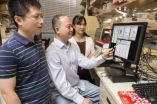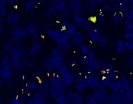(Press-News.org) That mountain lions have managed to survive at all in the Santa Monica Mountains of California—in the vicinity of the megacity of Los Angeles—is a testament to the resilience of wildlife, but researchers studying these large carnivorous cats now show in the Cell Press journal Current Biology on August 14 that the lions are also completely isolated, cut off from other populations by the freeway. According to the researchers' analyses, only one young mountain lion successfully dispersed into the Santa Monica Mountains in a decade.
Due to their almost complete isolation, the Santa Monica mountain lions show dangerously low levels of genetic diversity, the study shows. The circumstances have also made the Los Angeles-area cats incredibly sensitive to individual behaviors. That single male that immigrated in 2009 and successfully mated substantially enhanced the genetic diversity of the entire population all on his own.
"Many of these phenomena, including very low genetic diversity and close inbreeding, have only been previously seen in Florida panthers, an endangered and completely isolated population of mountain lions," says Seth Riley of the National Park Service. "In our case, the fact that lions in the Santa Monica Mountains are completely surrounded by roads and development likely lead[s] to behaviors that would be rare or nonexistent if normal population and social processes could occur."
Among those behaviors, Riley and his colleagues found evidence of close inbreeding events between fathers and daughters and of intraspecific killing, even of offspring, siblings, and mates, all behaviors that the researchers suspect would be rare or nonexistent if sufficient movement between populations was possible.
While one male lion moved into the Santa Monica Mountains during the study period, to the researchers' knowledge not a single young mountain lion has successfully dispersed out, when normally 75% of young lions—all of the males and half of the females—would likely disperse. Riley says the one possible exception that proves the rule is a single male "who dispersed likely from the Santa Monica Mountains out to Griffith Park, where he lives in a tiny dead-end home range."
Increased connectivity is critical for the long-term survival of mountain lions and other wildlife in the region, Riley says. Unfortunately, no one was thinking about that 60 years ago when the Los Angeles freeway was built. As a result, Route 101 is a development corridor, with very little natural habitat on either side. Riley says the National Park Service, the California Department of Transportation, and other local agencies have been working for over a decade to try to obtain the funds for a wildlife crossing, ideally an overpass, for carnivores.
On the bright side, that one successful male immigrant shows that it might not take many successful crossings to get wild populations in much better shape at the genetic level. Otherwise, the future is easy to predict, Riley says.
"If wildlife connectivity is not considered and planned for, or improved in places like southern California where it has mostly been lost, large carnivores, which exist at very low densities and need to move great distances, will not persist."
INFORMATION:
Current Biology, Riley et al.: "Individual behaviors dominate the dynamics of an urban mountain lion population isolated by roads."
Freeways as fences, trapping the mountain lions of Los Angeles
2014-08-14
ELSE PRESS RELEASES FROM THIS DATE:
RNA-targeted drug candidate for Lou Gehrig's disease found
2014-08-14
By targeting RNA molecules that tangle and clump in the nervous systems of patients with the most common genetic form of amyotrophic lateral sclerosis (ALS or Lou Gehrig’s disease) and frontotemporal dementia (FTD), researchers have shown they can effectively limit those damaging elements in cells taken from patients. The results reported in the Cell Press journal Neuron on August 14th show that RNA is a viable drug target for the two overlapping and incurable neurodegenerative diseases. The abnormal proteins derived from that aberrant RNA might also serve as biomarkers ...
Disruption of gut bacteria early in life can lead to obesity in adulthood
2014-08-14
Certain microbes found in the gut may protect against obesity and diabetes. A study published by Cell Press August 14th in the journal Cell reveals that these microbes shape their hosts' metabolism very early in life and that disrupting them with short-term exposure to antibiotics during infancy can cause metabolic changes that appear to increase the risk of obesity in adulthood. These findings in mice are helping researchers identify which gut bacteria are crucial to metabolic health. Such information could be used to help restore levels of those helpful microbes after ...
New shock-and-kill approach could eradicate barrier to curing HIV
2014-08-14
Despite tremendous progress in combatting HIV-1 infection with antiretroviral therapy, there is still no cure for the disease because these drugs do not kill a hidden reservoir of infected cells in the body. A study published by Cell Press August 14th in the journal Cell reveals a multipronged strategy for eradicating this latent reservoir and preventing HIV-1 from rebounding after treatment is stopped in mice. The findings suggest that a "shock-and-kill" approach involving the activation of dormant viruses with drugs called inducers, combined with virus-fighting antibodies, ...
Early antibiotic exposure leads to lifelong metabolic disturbances in mice
2014-08-14
VIDEO:
Martin Blaser, M.D., and Laura Cox, Ph.D., discuss their work on early antibiotic exposure in mice.
Click here for more information.
NEW YORK, August 14, 2014 — A new study published today in Cell suggests that antibiotic exposure during a critical window of early development disrupts the bacterial landscape of the gut, home to trillions of diverse microbes, and permanently reprograms the body's metabolism, setting up a predisposition to obesity. Moreover, the study shows ...
Computation and collaboration lead to significant advance in malaria
2014-08-14
HOUSTON – (August 14, 2014) -- Researchers led by Baylor College of Medicine have developed a new computational method to study the function of disease-causing genes, starting with an important new discovery about a gene associated with malaria – one of the biggest global health burdens.
The work published today in the current issue of the journal Cell includes collaborators comprised of computational and evolutionary biologists and leading malaria experts from Baylor, Columbia University Medical Center, Princeton University, Pennsylvania State University and the National ...
Researchers identify a brain 'switchboard' important in attention and sleep
2014-08-14
VIDEO:
Michael Halassa, M.D., Ph.D. discusses his work with the thalamic reticular nucleus (TRN) and it's importance in identifying new targets for treating various psychiatric disorders like schizophrenia, autism and post-traumatic...
Click here for more information.
New York City, August 14, 2014 - Researchers at NYU Langone Medical Center and elsewhere, using a mouse model, have recorded the activity of individual nerve cells in a small part of the brain that works as a "switchboard," ...
Genetic signal prevents immune cells from turning against the body
2014-08-14
LA JOLLA—When faced with pathogens, the immune system summons a swarm of cells made up of soldiers and peacekeepers. The peacekeeping cells tell the soldier cells to halt fighting when invaders are cleared. Without this cease-fire signal, the soldiers, known as killer T cells, continue their frenzied attack and turn on the body, causing inflammation and autoimmune disorders such as allergies, asthma, rheumatoid arthritis, multiple sclerosis and type 1 diabetes.
Now, scientists at the Salk Institute have discovered a key control mechanism on the peacekeeping cells that ...
Common mutation successfully targeted in Lou Gehrig's disease and frontotemporal dementia
2014-08-14
JUPITER, FL, August 14, 2014 – An international team led by scientists from the Florida campuses of The Scripps Research Institute (TSRI) and the Mayo Clinic have for the first time successfully designed a therapeutic strategy targeting a specific genetic mutation that causes a common form of amyotrophic lateral sclerosis (ALS), better known as Lou Gehrig's disease, as well a type of frontotemporal dementia (FTD).
The scientists developed small-molecule drug candidates and showed they interfere with the synthesis of an abnormal protein that plays a key role in causing ...
Scientists use lasers to control mouse brain switchboard
2014-08-14
VIDEO:
Scientists studied how just a few nerve cell in the mouse brain may control the switch between internal thoughts and external distractions. Using optogenetics, a technique that uses light-sensitive molecules...
Click here for more information.
Ever wonder why it's hard to focus after a bad night's sleep? Using mice and flashes of light, scientists show that just a few nerve cells in the brain may control the switch between internal thoughts and external distractions. The ...
Long antibiotic treatments: Slowly growing bacteria to blame
2014-08-14
Whether pneumonia or sepsis – infectious diseases are becoming increasingly difficult to treat. One reason for this is the growing antibiotic resistance. But even non-resistant bacteria can survive antibiotics for some time, and that's why treatments need to be continued for several days or weeks. Scientists at the Biozentrum of the University of Basel showed that bacteria with vastly different antibiotic sensitivity coexist within the same tissue. In the scientific journal Cell they report that, in particular, slowly growing pathogens hamper treatment.
Many bacteria ...








